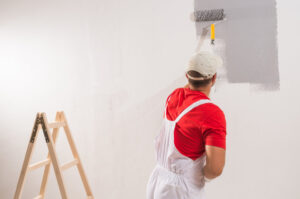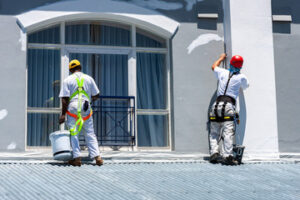Painters Anchorage specializes in projects that serve a business’s needs. They’re familiar with branding, working around customers’ schedules, and applying paint that will withstand high-traffic areas.
They also know how to work with various materials, including concrete, wood, and reinforced plastic. Punctuality is important to this role, as it demonstrates reliability and benefits positive working relationships.

Commercial painting involves more extensive tasks than residential painting because business structures are usually larger and have more walls and ceilings. In addition, commercial painters often provide power washing and sandblasting services, as well as wall covering installation. They also focus on making sure the paint job is weatherable and complies with local building codes. Because of the size of their jobs, it is common for commercial painters to work after hours and around customer schedules to ensure that their work is done without interrupting the flow of business.
Unlike residential painting, which primarily uses oil- or water-based paints, most businesses prefer to use industrial-grade paints that are more durable and require less maintenance. A skilled commercial painter can help a business choose the best colors and finishes to create a vibrant, welcoming atmosphere and protect interior surfaces from damage and wear.
A strong attention to detail is essential for a commercial painter, because small errors can have serious consequences. In addition to being able to spot flaws in the surface they are painting, they should be able to follow precise instructions for applying different types of coatings and sealers. This requires great patience and precision, as well as an ability to work under pressure.
Punctuality is another key trait for a commercial painter, as it shows reliability and demonstrates an eagerness to complete a project on time. It is also important to be able to communicate with clients about any delays or unexpected events that might affect the schedule.
While the skills and qualifications needed to be a commercial painter are largely the same as those required for any other trade, it is also a good idea for potential candidates to take classes or undergo training through an apprenticeship program to develop their career in this industry. Typical apprenticeships last between three and four years and combine on-the-job training with classroom instruction.
Although the work is physically demanding and can be dangerous, many commercial painters enjoy their jobs and find the perks rewarding. This is because the field offers a great deal of flexibility for people who are willing to invest the necessary time and effort.
Steel structural components in industrial facilities are exposed to harsh environments that can wreak havoc with them. Humidity, corrosive chemicals, extremes of heat or cold and abrasive wind can all damage structures and equipment over time. Industrial painting provides steel structural components with a protective coating to mitigate damage and extend their working life.
Structural coatings are a specialty application that requires specific experience and expertise to execute. The professionals at commercial painters can design a comprehensive coating solution that prevents interruptions in production schedules and meets strict industry specifications. The first step in this process is surface preparation. This could involve simply cleaning the surface or, in more complex cases, it could require abrasive blasting or other heavy-duty processes to remove contaminants such as chemicals, salt and rust. After the surface has been cleaned and prepared, the primer is applied. Depending on the situation, this may be an epoxy primer, or it might require polyurethane or other specialized primers to meet the specific needs of the project.
After the primer has cured, workers begin applying the base coats of the structure. They can use wet film gauges to measure coating thickness while it’s still wet and ensure that the dries at a manufacturer-specified thickness. They also apply multiple coats to achieve a uniform finish that protects the metal from corrosion, chemical exposure and other environmental conditions.
Once the dries, the contractor’s QC inspector visually inspects the work to detect any flaws in the dried coating. Once the inspection is complete and any deficiencies have been corrected, the contractor can continue with the next phase of the project.
Commercial painters know that the work they do can disrupt a business’s productivity and bottom line, so they take measures to minimize disruption. They work during non-business hours, use low-odor paints and implement efficient painting methods to get the job done quickly and efficiently. They also create containment areas to keep debris from spreading to other parts of the facility. They also follow strict safety protocols and adhere to all local regulations to protect employees and customers.
Decorative paints offer an infinite number of possibilities to enhance walls and surfaces. They can be used to create contrasts of light and shadow or to highlight specific elements in a space. These types of paints also allow you to play with the effects and textures of materials, from stoneware and textiles to metals. This allows you to give each room a unique personality, as well as making it easier for customers to find the right colour.
A skilled commercial painter is able to transform any surface into an artistic creation. In addition to painting, these professionals can apply high-performance coatings and special decorative finishes. They can also learn stenciling and gold leafing, allowing them to take their artistry to the next level. These services are in demand, particularly as more people embrace the idea of turning their homes and workspaces into true works of art.
The global architectural coatings market consists of a wide range of paints and stains that are applied to interior and exterior surfaces in both residential and commercial buildings. They include surface preparatory products such as putty and primer; paints that are used for aesthetic and protective purposes, including weather resistance, washability and anti-fungal properties; and staining and waterproofing paints. These products are usually used at room temperature and can be applied to wood, masonry, stucco and concrete.
In addition to offering decorative painting services, many commercial painters also provide floor coatings. These are opaque coatings that can be applied to a variety of flooring, and can protect them from scratches, water damage, abrasions, harsh chemicals and more. They are usually used in areas where foot traffic is heavy and can help prolong the life of flooring.
Another growing trend in the industry is the development of eco-friendly formulations. As more people become aware of the impact their choices have on the planet, there is a demand for coatings that can minimise their ecological footprint. This includes low-VOC (volatile organic compounds) paints, as well as sustainable sourcing of raw materials. These trends will continue to shape the future of the paints and coatings industry.
Unlike residential painting, commercial projects tend to be on a much larger scale and require more planning. Often, this includes working during business hours to minimize disruptions for customers and employees. It also requires using paint that can withstand high levels of traffic and resist damage from regular use.
Whether working on interior or exterior surfaces, professional commercial painters are trained to help clients select the best colors for their needs. They are also skilled in surface preparation, brushing, spraying and rolling techniques. They also understand the importance of utilizing low or no-VOC paints to protect indoor air quality.
They are able to work around a client’s scheduling needs and are familiar with working in public areas, like hospitals or retail spaces. They can also suggest the right color to compliment a company’s branding and design a space that will encourage customer engagement.
Commercial painters are used to collaborating with contract laborers and the project manager or foreman on larger projects. They are also experienced in communicating with clients and taking feedback. This is a key part of the job and should be viewed as constructive for improving overall project outcomes.
Reliability is important for a commercial painter because many jobs are time-sensitive and depend on team members to be punctual. Being dependable is beneficial for everyone involved and shows that the painter can be trusted to keep deadlines, regardless of how complex the project may be.
The ability to follow directions is another essential skill for a commercial painter. This is because most projects require a lot of coordination between several teams and the client. Being able to follow instructions is vital for a smooth process and ensures that each member of the team has their role in the finished product.
It is important for commercial painters to be able to identify and repair cracks, chips or stains in walls before they are painted. This helps to prevent problems from recurring and can extend the life of the paint job. It also helps the finish look cleaner and more appealing, which is an important aspect of a business’s image.






